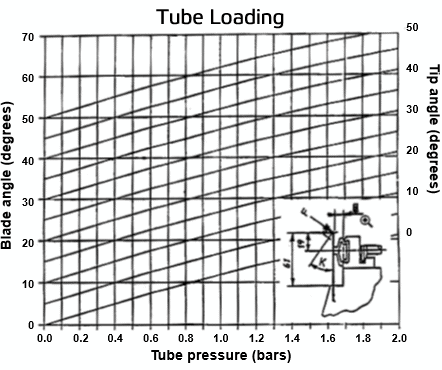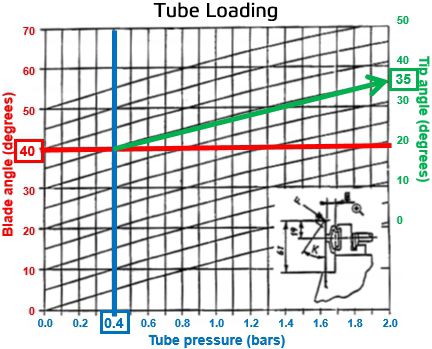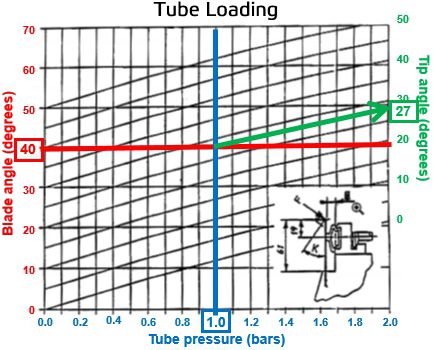Understanding coater blade angle vs. loading tube pressure
Jan 14, 2020
Tip angle vs. loading pressure
Below is a chart (Figure 1) showing how the tip angle changes with changes in tube loading pressures at a given beam angle. Your coater may vary slightly based on width and thickness of the coater blade, free extension above the air tube and tube dimensions. This chart is for a 0.015” thick blade and gives a good idea of this relationship.

Figure 1 - Coater blade loading tube curve
What happens when pressure is increased?
For a given blade tip bevel, when load tube pressure is increased, the blade angle will decrease, resulting in the blade running on its heel for a while. This, along with the additional bending pressure at the blade tip, will reduce coat weight. The relationship between increasing blade loading pressure and subsequent decreasing blade tip angle is illustrated in Figure 2.

Figure 2 – Tip angle (35°) at initial blade angle (40°) and tube pressure (0.4 bars)
In this case, the blade (beam) angle is held constant at 40 degrees, as shown by the horizontal red line. The initial tube (blade loading) pressure is 0.4 bars, signified by the vertical blue line. They intersect at the angled (green) tip angle line which, when followed up and to the right, shows that the tip angle is 35 degrees.
When the blade angle is held constant at 40 degrees, and the tube pressure is increased to 1.0 bars, as shown in Figure 3, the tip angle becomes 27 degrees, i.e. the tip angle decreases when loading pressure increases.

Figure 3 – Tip angle decreases to 27° at constant blade angle (40°) and increased tube pressure (1.0 bars).
After a short time, the steel blade will wear the heel down resulting in more land area once again. This increases coat weight a little - but not as much as before the added blade load pressure was applied.
Over time, the blade load pressure will slowly increase until a point is reached where coat weight control, coat weight profiles, or weeping are uncontrollable and require a blade change.
May need to adjust beam angle
When using carbide or ceramic blades in place of blue steel blades, it may be necessary to adjust beam angle to stay on the ground bevel and attain coat weight and sheet smoothness targets. Unlike the steel blades, these blades will not wear in to a new tip angle if the blade load pressure changes. However, once the blade beam angle is optimized for a given ceramic or carbide coater blade geometry, the load tube pressures should stay much more uniform.
Proper blade bevel
To repeat a previous field report topic, the blade bevel should be parallel to slightly converging on the applicator roll from the blade heel to its toe. Riding too much on the heel will lower coat weight and may cause wet bleeding at the blade due to a diverging nip. Riding on the blade tip will increase coat weight and may cause weeping on the blade, coating scratches and poor sheet smoothness.
If you are interested in finding out more about blade coater setup, contact your Valmet representative.